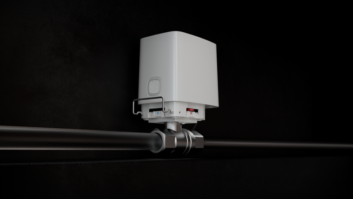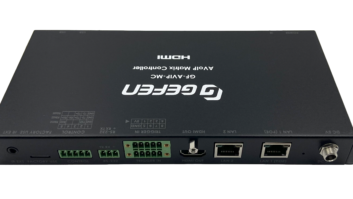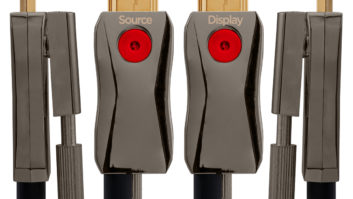Getting a Signal to Go Farther with Antennas, Wi-Fi, and IR Extenders

Utilizing the HomePlug-based product from Plaster Networks can help extend a home network signal over an existing powerline. And, thanks to a variety of remote monitoring and diagnostic tools, the company also makes it easy to see when a “noisy” device is online by simply viewing the monitor and seeing when the throughput drops or goes back to spec when a specific appliance is plugged in or not.
For the custom installation professional, a perfect world would probably be one where all jobs were started from scratch, offering full access to all walls before they are covered, and with conduit running everywhere to allow for additional runs after the sheetrock was hung. Of course, there would be a network jack everywhere one could possibly be needed, at the end of the job or anywhere in the future. Along with that, there would be perfect reception and availability of every terrestrial, cable or satellite-delivered service with no outages. Within the residence, where wireless is required for mobile devices, the QoS and bandwidth would be equal to that of the wired backbone.
We can all dream, can’t we? In the real world, the wireless system’s range isn’t always what might have been projected once the walls are up. In the real world there are outages from the cable or satellite system from time to time. In the real world, data systems go down and take IP phones with them, as the better part of Southern California found out in early December when Time Warner’s data service went down even while the standard “cable” video programming was fine. In the real world you sometimes need to make do with a basic, rather than sophisticated solution to a problem of getting data, commands or content from one place to another.
As we live in the real world, and some of those real-world situations will require some reasonably priced solutions to extend the range of things or insure their availability even if some of the solutions may at first glance seem obvious.
Indoor Antenna Options
While most systems installed by CEDIA ESCs bring in local channels via cable or satellite, there are still many of the “sub-channels” that are not carried on those services. In our perfect world, an outdoor antenna is the best solution to this problem, but when that’s not possible, there’s a new generation of indoor antennae, many of which are a far cry from the “rabbit ears” of days gone by.

A favorite indoor antenna of many has long been the Silver Sensor, now sold under the Philips brand, and I’ve had great success with a similarly designed product sold by Terk, called the HDTVA/HDTVI. Designed like mini outdoor yagi arrays, they are directional and a bit hard to hide in a room, but they definitely do the trick if the home is in decent range of the local TV station antennae.
While flat-panel-type indoor models are more discrete, results with them are mixed. A recent addition to that form factor is the ClearStream Micron from Antennas Direct, which claims a 35-mile range that seems to check out in my informal testing. For locations a bit closer to the transmission towers (within 15 miles or so) they also offer a flat-panel indoor antenna built into a picture frame.
As you add an indoor, or for better range an outdoor antenna, as a backup or alternate signal source, don’t forget how this will impact any remote programming. Make certain that all the touch screens or macros on hand-held remotes are programmed to reflect this new input source and the audio that goes with it.
Extending WiFi Signals
Having creatively extended the range of program sources to include direct off-air terrestrial signals, one other type of signal that often needs extension is Wi-Fi. No matter how well you plan the infrastructure, sometimes there is simply a dead spot or two in a residence. Yes, you can try different access points, and sometimes that alone will do the trick. Switching to an 802.11n system might bring increased range, but even if it does that won’t help for products such as many laptops over a year or two old or with PS3 consoles that are limited to b/g wireless only at this time.
This is where enterprise-grade products might do the trick, or perhaps replacing the antenna with a higher gain replacement for the standard “rubber duckie” antenna might also give just enough extra boost to do the trick.
Not all consumer access points have external antennae these days, though many enterprise models do. In that case an interesting solution is on the way from Antennas Direct. The company’s Wi-Fi Distribution Kit, first previewed at CEDIA EXPO back in September, cleverly includes the parts to replace the access point’s antenna with a connection that diplexes into the home’s internal coax distribution system, riding the Wi-Fi signal along with the existing off-air or cable signal. Then, at the place where you now have a simple coax connection, you place one of the supplied diplexers inside the wall box and connect one lead to a standard coax jack for the TV connection and the other to an SMA connector that attaches to a small antenna on the wall plate.

The ClearStream Micron, introduced by Antennas Direct president Richard Schneider at CEDIA EXPO last September, claims a 35-mile range that seems to check out in informal testing. For locations a bit closer to the transmission towers (within 15 miles or so) they also offer a flat-panel indoor antenna built into a picture frame.
The end result is that you’ve used the existing infrastructure to extend the wireless range to four, or up to eight additional antennae. As with anything involving RF, there are always issues that might limit the usability in some situations, but if it works as it should this could be one trick to keep in your back pocket.
No New Wires Solutions
Of course, there are simply times when even the most imaginative solutions won’t extend wireless to where you need to have broadband connectivity, and that is where “no new wires” solutions come into play. Coming out of CEDIA EXPO, MoCA technology appears to once again becoming a potential contender. A more developed technology is the use of AC power lines to carry the broadband signal, and given their ubiquity it is something that can be placed almost anywhere in the home.
This technology has been around in a variety of forms and standards for some time, but with the current HomePlug Alliance standards it is clearly ready for prime time with throughput to 200 Mbps and beyond. One interesting take on this comes from Plaster Networks, whose products offer fast throughput and have worked better than any previous such technology in my home test bed. More interestingly, thanks to a variety of remote monitoring and diagnostic tools, Plaster Networks makes it easy to see when a “noisy” device is online by simply viewing the monitor and seeing when the throughput drops or goes back to spec when a specific appliance is plugged in or not. Armed with that data it is easy to use a powerline isolator to filter the noise caused by the offending device.
Stepping up the game, it is also worth noting that the first powerline AV adaptor to claim 500Mbps has been announced by TRENDnet. I haven’t had a chance yet to test it, but the concept is intriguing, even if the real-world performance is only half of the claimed data rate.

When the job is on a tight budget and it is simply a case of wanting to convert a product’s remote from IR to RF to get behind cabinet doors or work from a different room without a great deal of programming or hassle, NextGen’s “Remote Extender” takes care of the job quickly and easily.
Extending an IR Signal
Another common problem where extending a product’s range is often problematic is with IRbased remote controls. Clearly, any designer/ installer worth the title has a full bag of tricks that include their favorite mix of IR extenders, blasters, and similar products, but sometimes the only way to do the trick is with an IR to RF adaptor. These, too, have been around for a while, and commercial strength solutions such as URC’s MRF series products do the trick in sophisticated installations.
However, when the job is on a tight budget and it is simply a case of wanting to convert a product’s remote from IR to RF to get behind cabinet doors or work from a different room without a great deal of programming or hassle, NextGen’s “Remote Extender” takes care of the job quickly and easily.
This is a product that truly fits the old cliché of “…it’s so simple a child can do it.” Replace one of the AAA or AA batteries in the remote to be switched to RF with the supplied sleeve containing a rechargeable battery, place the RF receiver where the device(s) to be controlled are, select either 433 or 418 MHz as the operating frequency as is appropriate to the installation, place the IR emitter near the devices under control and you’re good to go. No programming of codes into a new remote, no setup, no nothing. It’s amazingly simple, yet it worked like a charm. The kit even comes with a spare battery and the “flying saucer” looking RF receiver that doubles as a charging station. Yes, this is a basic consumer product, but if it solves a problem, isn’t that the name of the game?
Indeed, extending range is sometimes about using the right product to stretch how far broadband service, remote commands or off-air signals can go to suit the needs of a particular installation. At the same time, it is also a good metaphor to opening your vistas to finding the right product to extend the range of your service offerings, no matter what it’s main market or intended use.
Michael Heiss is a contributing editor to Residential Systems, based in Los Angeles.







